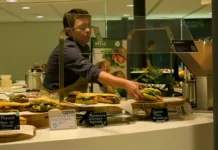When two worlds collide neither of them can escape. The modern society is on a collision course with the natural order. Therefore, can we avoid ecological catastrophe and the demise of the human species? There is still time….
Only if we transform the relationship between the world were are living in and ourselves. On the contrary, the collision of two worlds provides answers to ethical, political and socio-economical questions and set the basis to develop a sustainable society. But why do we have to wait until the damage is done?
The installation “Dreamscape” at TAC (Temporary Art Center) [1] shows an observation of space habitats. Similar to life on our planet, each sphere has its own characteristics and eligibility. The question is if the spheres may merge in harmony or clash and destroy. This visual and language experience brings a dreamlike state of mind. Dreamscape captures the imagination of a tangible and poetic approach directed by Iris Frankhuizen of STILL productions. In overall, it urges to address a certain emotion, mood or experience to the viewer.
Similarly, a summary report to address a natural and human collision was released on May 6, 2019. An emergency report detailing past losses and future prospects for nature and humans that evokes the reader’s emotion, mood or experience just like Dreamscape. The report is entitled: “IPBES Global Summary” by The Intergovernmental Science-Policy Platform on Biodiversity and Ecosystem Services (IPBES) [2]. The summary was approved at the 7th session of the IPBES Plenar (29 April – 4 May 2019) in Paris, France.
The Report assesses changes over the past five decades, providing a comprehensive picture of the relationship between economic development pathways and their impacts on nature.
Nature
Nature is essential for human existence and its contribution is distributed unequally across various levels of society. The contribution of nature can either be irreplaceable (e.g. oil, natural gas, etc.) or not fully replaceable (e.g. water, animal life, etc.).
Currently, more food, energy and materials are now being delivered to people in most places, that undermines the nature’s ability to provide in the future. The biosphere, upon which humanity as a whole depends, is being altered to an unparalleled degree across all scales. Biodiversity – the diversity within species, between species and of ecosystems – is declining more rapidly than ever in human history [2].
Imminent collision
Human actions are threatening more species with global extinction. According to the IPBES report, an average of around 25% of species in the assessed animal and plant groups are at risk. As a result, approximately 1 million species are already facing extinction, many in decades, unless action is taken to reduce the intensity of biodiversity loss drivers such as:
- changes in land and sea use;
- direct exploitation of organisms;
- climate change;
- pollution;
- and invasion of alien species.
The imminent collision with nature is the result of human social values and behaviours that include: production and consumption patterns; human population dynamics and trends; trade; technological innovations; and local through global governance. Examples of the current human negative actions are:
- three-quarters of the land-based environment and about 66% of the marine environment have been significantly altered [2];
- more than a third of the world’s land surface and nearly 75% of freshwater resources are now devoted to crop or livestock production [2].
The IPBES report delivers a better understanding of the main causes of damage to nature and the complex global connection to human negative drivers.
Future
The IPBES Chair, Sir Robert Watson stated: “The loss of species, ecosystems and genetic diversity is already a global and generational threat to human well-being [and nature]. Protecting the invaluable contributions of nature to people will be the defining challenge of decades to come. Policies, efforts and actions – at every level – will only succeed, however, when based on the best knowledge and evidence”.
The Human collision with Nature is detectable when we look at a global picture.
For example, the goals for conserving nature and achieving sustainability cannot be met by current human trajectories, such as the 2030 Agenda for Sustainable Development [3], the Paris Agreement on Climate Change [4] and the 2050 Vision for Biodiversity [5].
It is quite obvious that in recent decades human rights have been promoted to a healthy environment. The notion of ecological human rights limitations, however, should be addressed now more than ever before. One might therefore ask:
- Is the natural environment merely a value to be added to the list of individual demands or a condition of life that requires human freedom to be restricted?
- Is human freedom determined not only by the context of society but also by an ecological context?
Understanding that the natural environment has intrinsic value, not just instrumental value, is only the beginning. Sometimes, when two worlds collide, a better one is device; but only if we start now at every level from local to global to conserved and restored nature.
For Eindhoven News: Brian Cano
[1] https://www.tac.nu
[2]https://www.ipbes.net/sites/default/files/downloads/spm_unedited_advance_for_posting_htn.pdf
[3] https://sustainabledevelopment.un.org/post2015/transformingourworld
[4] https://unfccc.int/process-and-meetings/the-paris-agreement/the-paris-agreement
[5] https://www.cbd.int/doc/meetings/sbstta/sbstta-21/official/sbstta-21-02-en.pdf
















